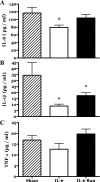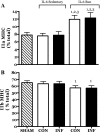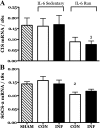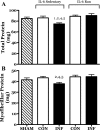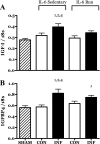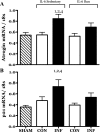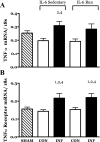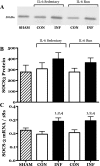Skeletal muscle growth in young rats is inhibited by chronic exposure to IL-6 but preserved by concurrent voluntary endurance exercise - PubMed (original) (raw)
Skeletal muscle growth in young rats is inhibited by chronic exposure to IL-6 but preserved by concurrent voluntary endurance exercise
P W Bodell et al. J Appl Physiol (1985). 2009 Feb.
Abstract
Childhood diseases are often accompanied by chronic inflammation, which is thought to negatively impact growth. Interleukin-6 (IL-6) is typically cited as an indicator of inflammation and is linked to impaired growth. This study was designed to isolate and identify potential effects of chronic IL-6 exposure on skeletal muscle growth during development. A second aim was to determine if endurance exercise, thought to antagonize chronic inflammation, would interact with any effects of IL-6. The muscles of one leg of rapidly growing rats were exposed to IL-6 or vehicle for 14 days. Subgroups of IL-6-infused rats were provided access to running wheels. Local IL-6 infusion resulted in approximately 13% muscle growth deficit (myofibrillar protein levels). Exercise (>4,000 m/day) prevented this deficit. IL-6 infusion increased mRNA for suppressor of cytokine signaling-3 (SOCS3) and tumor necrosis factor-alpha (TNF-alpha), and this was not prevented by exercise. IL-6 infusion increased the mRNAs for atrogin, insulin-like growth factor-I (IGF-I), and IGF binding protein-4 (IGFBP4), and these effects were mitigated by exercise. Exercise stimulated an increase in total RNA ( approximately 19%) only in the IL-6-infused muscle, suggesting that a compensatory increase in translational capacity was required to maintain muscle growth. This study indicates that IL-6 exposure during periods of rapid growth in young animals can retard growth possibly via interactions with key growth factors. Relatively high volumes of endurance-type exercise do not exacerbate the negative effects of IL-6 and in fact were found to be beneficial in protecting muscle growth.
Figures
Fig. 1.
Changes in body mass during 14 days of localized muscle infusion of vehicle (sham), IL-6, or IL-6 plus concurrent voluntary running. #P < 0.05 vs. sham and IL-6.
Fig. 2.
Blood plasma concentrations of selected cytokines during 14 days of localized muscle infusion of vehicle (sham), IL-6, or IL-6 plus concurrent voluntary running. *P < 0.05 vs. sham.
Fig. 3.
Effects of 14 days of localized muscle infusion of vehicle (sham), IL-6, or IL-6 plus concurrent voluntary running on myosin heavy chain (MHC) type IIa (A) and type IIb (B) protein proportions in rat medial gastrocnemius (MG) muscles. CON, contralateral muscle; INF, IL-6-infused muscle. 1 P < 0.05 vs. sham; 2 P < 0.05 vs. sedentary IL-6 contralateral. 3 P < 0.05 vs. sedentary IL-6 infused.
Fig. 4.
Effects of 14 days of localized muscle infusion of vehicle (sham), IL-6, or IL-6 plus concurrent voluntary running on IL-6 receptor mRNA levels in rat MG muscles. 1 P < 0.05 vs. sham. 2 P < 0.05 vs. sedentary IL-6 contralateral. 3 P < 0.05 vs. sedentary IL-6 infused.
Fig. 5.
Effects of 14 days of localized muscle infusion of vehicle (sham), IL-6, or IL-6 plus concurrent voluntary running on mRNA levels for CIS (A) and suppressor of cytokine signaling 2 (SOCS2) (B) in rat MG muscles. 2 P < 0.05 vs. sedentary IL-6 contralateral. 3 P < 0.05 vs. sedentary IL-6 infused.
Fig. 6.
Effects of 14 days of localized muscle infusion of vehicle (sham), IL-6, or IL-6 plus concurrent voluntary running on MG muscle total (A) and myofibrillar (B) protein content. 1 P < 0.05 vs. sham. 2 P < 0.05 vs. sedentary IL-6 contralateral. 4 P < 0.05 vs. run contralateral muscle. 5 P < 0.05 vs. IL-6-infused run muscle.
Fig. 7.
Effects of 14 days of localized muscle infusion of vehicle (sham), IL-6, or IL-6 plus concurrent voluntary running on the level of IGF-I (A) and IGF binding protein 4 (IGFBP4) (B) mRNA present in rat MG muscle. 1 P < 0.05 vs. sham. 2 P < 0.05 vs. sedentary IL-6 contralateral. 4 P < 0.05 vs. run contralateral muscle.
Fig. 8.
Effects of 14 days of localized muscle infusion of vehicle (sham), IL-6, or IL-6 plus concurrent voluntary running on the IGF-I/insulin receptor (IGFR1) protein level present in rat MG muscle. 1 P < 0.05 vs. sham. 2 P < 0.05 vs. sedentary IL-6 contralateral.
Fig. 9.
Effects of 14 days of localized muscle infusion of vehicle (sham), IL-6, or IL-6 plus concurrent voluntary running on the level of procollagen III (Col-3) mRNA present in rat MG muscle. 1 P < 0.05 vs. sham. 2 P < 0.05 vs. sedentary IL-6 contralateral. 4 P < 0.05 vs. run contralateral muscle.
Fig. 10.
Effects of 14 days of localized muscle infusion of vehicle (sham), IL-6, or IL-6 plus concurrent voluntary running on the level of atrogin (A) and p21 (B) mRNA present in rat MG muscle. 1 P < 0.05 vs. sham. 2 P < 0.05 vs. sedentary IL-6 contralateral. 4 P < 0.05 vs. run contralateral muscle.
Fig. 11.
Effects of 14 days of localized muscle infusion of vehicle (sham), IL-6, or IL-6 plus concurrent voluntary running on the amount of total RNA (A) and the ratio of total protein to total RNA (B) present in rat MG muscle. 1 P < 0.05 vs. sham. 2 P < 0.05 vs. sedentary IL-6 contralateral. 4 P < 0.05 vs. run contralateral muscle.
Fig. 12.
Effects of 14 days of localized muscle infusion of vehicle (sham), IL-6, or IL-6 plus concurrent voluntary running on the level of TNF-α (A) and TNF-α receptor (B) present in rat MG muscle. 1 P < 0.05 vs. sham. 2 P < 0.05 vs. sedentary IL-6 contralateral. 4 P < 0.05 vs. run contralateral muscle.
Fig. 13.
Effects of 14 days of localized muscle infusion of vehicle (sham), IL-6, or IL-6 plus concurrent voluntary running on the level of SOCS3 mRNA and protein present in rat MG muscle. Representative immunoblot for SOCS3 protein (A), SOCS3 protein in densitometer units (not significant) (B), and SOCS3 mRNA (C). 1 P < 0.05 vs. sham. 2 P < 0.05 vs. sedentary IL-6 contralateral. 4 P < 0.05 vs. run contralateral muscle.
Similar articles
- Ghrelin inhibits skeletal muscle protein breakdown in rats with thermal injury through normalizing elevated expression of E3 ubiquitin ligases MuRF1 and MAFbx.
Balasubramaniam A, Joshi R, Su C, Friend LA, Sheriff S, Kagan RJ, James JH. Balasubramaniam A, et al. Am J Physiol Regul Integr Comp Physiol. 2009 Apr;296(4):R893-901. doi: 10.1152/ajpregu.00015.2008. Epub 2009 Feb 11. Am J Physiol Regul Integr Comp Physiol. 2009. PMID: 19211729 - Combined isometric, concentric, and eccentric resistance exercise prevents unloading-induced muscle atrophy in rats.
Adams GR, Haddad F, Bodell PW, Tran PD, Baldwin KM. Adams GR, et al. J Appl Physiol (1985). 2007 Nov;103(5):1644-54. doi: 10.1152/japplphysiol.00669.2007. Epub 2007 Sep 13. J Appl Physiol (1985). 2007. PMID: 17872405 - Hormone, cytokine, and nutritional regulation of sepsis-induced increases in atrogin-1 and MuRF1 in skeletal muscle.
Frost RA, Nystrom GJ, Jefferson LS, Lang CH. Frost RA, et al. Am J Physiol Endocrinol Metab. 2007 Feb;292(2):E501-12. doi: 10.1152/ajpendo.00359.2006. Epub 2006 Sep 26. Am J Physiol Endocrinol Metab. 2007. PMID: 17003238 - Alteration of somatotropic function by proinflammatory cytokines.
Frost RA, Lang CH. Frost RA, et al. J Anim Sci. 2004;82 E-Suppl:E100-109. doi: 10.2527/2004.8213_supplE100x. J Anim Sci. 2004. PMID: 15471789 Review. - Interleukin-6 myokine signaling in skeletal muscle: a double-edged sword?
Muñoz-Cánoves P, Scheele C, Pedersen BK, Serrano AL. Muñoz-Cánoves P, et al. FEBS J. 2013 Sep;280(17):4131-48. doi: 10.1111/febs.12338. Epub 2013 Jun 18. FEBS J. 2013. PMID: 23663276 Free PMC article. Review.
Cited by
- Daily Eicosapentaenoic Acid Infusion in IUGR Fetal Lambs Reduced Systemic Inflammation, Increased Muscle ADRβ2 Content, and Improved Myoblast Function and Muscle Growth.
Beer HN, Lacey TA, Gibbs RL, Most MS, Hicks ZM, Grijalva PC, Marks-Nelson ES, Schmidt TB, Petersen JL, Yates DT. Beer HN, et al. Metabolites. 2024 Jun 18;14(6):340. doi: 10.3390/metabo14060340. Metabolites. 2024. PMID: 38921474 Free PMC article. - Physical Activity and Diet in Older Women: A Narrative Review.
Mattioli AV, Selleri V, Zanini G, Nasi M, Pinti M, Stefanelli C, Fedele F, Gallina S. Mattioli AV, et al. J Clin Med. 2022 Dec 22;12(1):81. doi: 10.3390/jcm12010081. J Clin Med. 2022. PMID: 36614882 Free PMC article. Review. - Cancer Cachexia: Signaling and Transcriptional Regulation of Muscle Catabolic Genes.
Rao VK, Das D, Taneja R. Rao VK, et al. Cancers (Basel). 2022 Aug 31;14(17):4258. doi: 10.3390/cancers14174258. Cancers (Basel). 2022. PMID: 36077789 Free PMC article. Review. - Going Up Inflame: Reviewing the Underexplored Role of Inflammatory Programming in Stress-Induced Intrauterine Growth Restricted Livestock.
Hicks ZM, Yates DT. Hicks ZM, et al. Front Anim Sci. 2021 Nov;2:761421. doi: 10.3389/fanim.2021.761421. Epub 2021 Nov 4. Front Anim Sci. 2021. PMID: 34825243 Free PMC article.
References
- Adams GR, Haddad F, Baldwin KM. Time course of changes in markers of myogenesis in overloaded rat skeletal muscles. J Appl Physiol 87: 1705–1712, 1999. - PubMed
- Adams GR, Haddad F, Bodell PW, Tran PD, Baldwin KM. Combined isometric, concentric and eccentric resistance exercise prevents unloading induced muscle atrophy in rats. J Appl Physiol 103: 1644–1654, 2007. - PubMed
- Adams GR, Hather BM, Baldwin KM, Dudley GA. Skeletal muscle myosin heavy chain composition and resistance training. J Appl Physiol 74: 911–915, 1993. - PubMed
- Adams GR, McCue SA. Localized infusion of IGF-I results in skeletal muscle hypertrophy in rats. J Appl Physiol 84: 1716–1722, 1998. - PubMed
- Al-Khalili L, Bouzakri K, Glund S, Lonnqvist F, Koistinen HA, Krook A. Signaling specificity of interleukin-6 action on glucose and lipid metabolism in skeletal muscle. Mol Endocrinol 20: 3364–3375, 2006. - PubMed
Publication types
MeSH terms
Substances
LinkOut - more resources
Full Text Sources
Molecular Biology Databases
Miscellaneous

